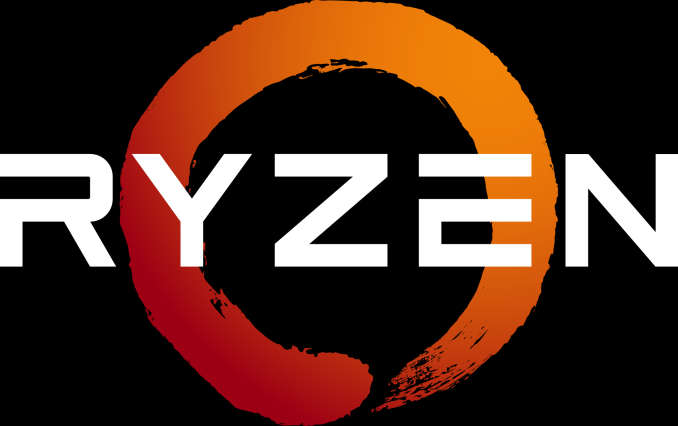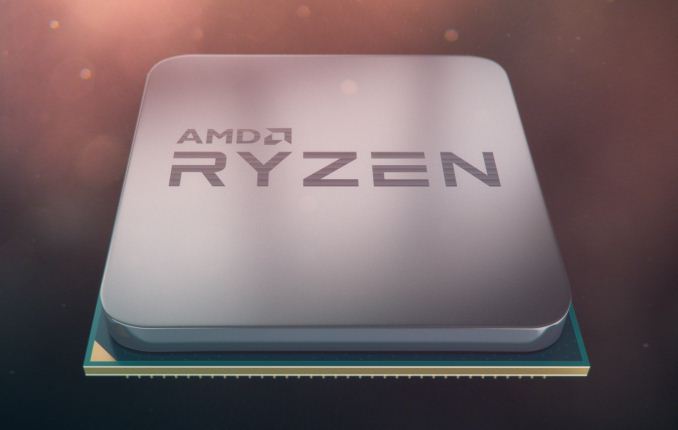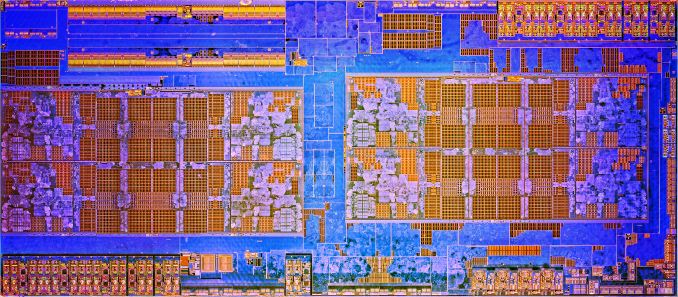AMD Launches Ryzen: 52% More IPC, Eight Cores for Under $330, Pre-order Today, On Sale March 2nd
by Ian Cutress on February 22, 2017 9:00 AM EST
The biggest x86 launch for AMD in five years is today: Ryzen is here. As always before a major launch, AMD gives a ‘Tech Day’ for relevant press and analysts, and through this event AMD’s CEO, Dr. Lisa Su lifted the lid on one of the most anticipated products in the semiconductor industry. AMD knows how to control the level of enthusiasm for its fans, and today is the end result, with processors going on pre-order from major retailers today at 1pm EST, ready for a general hard launch on March 2nd.
In a similar vein to launches of recent smartphones, AMD is doing a staggered announcement/launch with the products on their new microarchitecture. Where Samsung/Apple might give all the details for a product a few weeks before it’s available to buy, today on February 22nd marks the day where AMD is giving consumers information about Ryzen, and specifically the Ryzen 7 family of eight-core products. All the information today is from AMD, and AMD’s internal testing, and pre-orders also start from today for users ready to put down their money for a launch day part. Reviews of the CPUs, as well as when the CPUs will ship to customers, is on March 2nd. This also happens to be right in the middle of two annual shows, Game Developer Conference (GDC) and Mobile World Congress (MWC), making the time between receiving pre-launch samples and being able to provide independent verification of AMD’s performance claims relatively frantic. We’ll do our best!
The Ryzen Family
With a new processor launch, naming the parts and positioning them within the market is critical. So with Ryzen, the processor stack will be split into three based on performance and price: Ryzen 7 at the high end, Ryzen 5 in the middle, and Ryzen 3 for more price-conscious consumers. Both Ryzen 5 and Ryzen 3 are set to be launched later, and Ryzen 7 is the first portion of the family to be released.
Ryzen 7 will have three CPUs to start, all having eight cores and supporting simultaneous multi-threading:
- Ryzen 7 1800X: 8C/16T, 3.6 GHz base, 4.0 GHz turbo, 95W, $499
- Ryzen 7 1700X: 8C/16T, 3.4 GHz base, 3.8 GHz turbo, 95W, $399
- Ryzen 7 1700: 8C/16T, 3.0 GHz base, 3.7 GHz turbo, $329
Ryzen 7 1800X will be the high-end part, featuring a base clock of 3.6 GHz and a turbo of 4.0 GHz, within a TDP of 95W, and for $499. Next to this is Ryzen 7 1700X, launching at $399, with a base/turbo of 3.4/3.8 GHz. The final part for the launch is the Ryzen 7 1700, providing eight cores and sixteen threads for $329 at 3.0/3.7 GHz frequencies.
Processors will initially be available for pre-order from 185 retailers and OEMs worldwide, either as individual parts or pre-built systems.
What, not 40% IPC? 52% IPC??
Enthusiasts and analysts use the term IPC, or ‘Instructions Per Clock’, as a measure of how much the underlying microarchitecture improves from generation to generation. Two decades ago, a good design on a smaller node could net a healthy double-digit gain, whereas in recent years 5-10% gain has become the norm. When AMD initially announced that the new Zen microarchitecture they were developing was aiming for a 40% IPC gain, despite the low IPC they were starting from, users remained skeptical. AMD rehired Jim Keller to work alongside long-term AMD architect Mike Clark and produce a team with several goals in mind: high-performance x86, simultaneous multithreading, and a product to be relevant in the computing, PC, server and mobile space again. So despite this, 40% IPC always seemed a somewhat lofty goal, because Bulldozer was so underwhelming, and despite this low starting point. For the Ryzen launch today, AMD is stating that the final result of that goal is a 52% gain in IPC.
This is something we will need to test in due course!
The Ryzen Silicon, and the Future
AMD pointed out that the new 8-core silicon design runs 4.8 billion transistors and features 200m of wiring. Through previous announcements we’ve examined parts of the microarchitecture including cache sizes, threading, front-end/back-end design, and so on.
AMD Zen Microarchiture Part 2: Extracting Instruction-Level Parallelism
AMD Gives More Zen Details: Ryzen, 3.4 GHz+, NVMe, Neural Net Prediction, & 25 MHz Boost Steps
AMD’s CEO was keen to point out that this is a from-scratch design for AMD, using the knowledge gained from features developed for previous products but ultimately under the hood it looks like ‘a typical x86 high-performance core’, with AMD-specific features and tweaks. We were told that AMD’s roadmap extends into the multi-year range, so while the focus for 2017 will be on this family of products, back at HQ the next two generations are in various stages of development.
BENCHMARKS PLEASE
So despite the 82+ motherboards going to be available, 19 initial PC system builders moving into 200+ through the first half of 2017, the big question on everyone’s lips is how exactly does it perform?
Well, AMD gave us the following numbers:
AMD's benchmarks showed that the top Ryzen 7 1800X, compared to the 8-core Intel Core i7-6900K, both at out-of-the-box frequencies, gives an identical score on the single threaded test and a +9% in the multi-threaded test. AMD put this down to the way their multi-threading works over the Intel design. Also, the fact that the 1800X is half of the price of the i7-6900K.
In a similar vein, again with the Cinebench 15 multi-threaded test, the Ryzen 7 1700X scores over and above the Core i7-6800K (its price competition) and higher than the Core i7-6900K which costs 2.5 times as much.
We’ll tell you what our benchmarks say, with official retail processors. But you will have to wait until March 2nd. Sorry.





















386 Comments
View All Comments
yhselp - Saturday, February 25, 2017 - link
Not everyone can afford or wants to pay for more expensive components. The G4560 has been somewhat of a hit in the budget sector - it's perfectly capable of handling many of the latest games, virtually all of the e-sports-oriented MOBA/MMO/FPS games and it costs $64 - it's hard to convince someone to spend over twice that because it's "always better". AMD does not have an answer for the super-budget sector; it also chose not price the base 4c/4t CPU aggressively at $99, here's hoping that's what happens when Intel inevitably makes the sub-$120 i3 4c/4t.Lolimaster - Sunday, February 26, 2017 - link
Your answer is the Raven Ridge APU 2c/4t and 4c/8t.Lolimaster - Sunday, February 26, 2017 - link
Why would you want a platform with no upgrade path except totally not worthy overpriced quad cores?AM4 R3 1100 4c/4t all the way to the best performance/price chip ever, the R7 1700 8c/16t for $320.
yhselp - Sunday, February 26, 2017 - link
Because it's affordable and it works, it does what you need it to do with satisfactory results. Why is it so hard to understand that some people just don't want to spend, or cannot afford to, on more expensive components? Many people simply do not upgrade; they buy a configuration and use it for years until it becomes hopelessly obsolete. AMD has a part for the budget conscious *performance* crowd - Ryzen 3 1100 - but it does not have an answer for the low-end sector. A G4560/H110/8GB/GTX1050 combo can play all popular MOBA/MMO/FPS games and many modern triple-As. You don't even need to add a video card if you don't need it for games.The non-laptop Raven Ridge would likely be a 4c/8t HBM2 SoC; it won't be a $65 CPU. However, if it's fast enough so that you wouldn't need to add a video card, then it just might be something very special.
Haawser - Sunday, February 26, 2017 - link
I think their answer for the ultra low budget sector will be unlocked Carrizo based Athlon x4s. Which should hit ~4GHz, ie- AM4 Bristol Ridge without an iGPU. The locked Athlon x4 845 is only $69, so I'd imagine an unlocked AM4 version would probably be similar.For a 1050/460 it would be OK. It can run a GTX1080 at nearly 80fps in The Division (http://www.guru3d.com/articles_pages/amd_athlon_x4... so I don't think a 1050 or 460 would cause it many problems ? And most importantly, from AMDs perspective, get people onto an AMD AM4 platform instead of an Intel one. So they can sell them an R3/R5 in future.
Just wait. I don't think AMD are going to ignore the ultra budget sector. I think they are going to offer unlocked Carrizo Athlon x4s. Which really aren't that bad. Particularly as they *do* have AVX, AVX2 etc.
yhselp - Monday, February 27, 2017 - link
It does make sense. I've no doubt AMD will address the low-end; I was just hoping it would be with a Zen core and sooner rather than later. If Zen can scale down to 2c/4t, it'd be nice to see an entry part for ~$50.Haawser - Monday, February 27, 2017 - link
Don't think it would be economic to cut down an 8 core Ryzen to 2 cores ? Think that's why they said the R3s would be the last ones to be launched. Because they are probably working on a separate 4C/8T die. They also said that there might be some more unannounced SKUs, so who knows ? Later in the year you might get a 2C/4T Ryzen ?eddiechi - Saturday, February 25, 2017 - link
and the pressure has already hit Intel and AMD hasn't been released yet for independent reviews...... INTEL JUST ANNOUNCE more than a dozen price cuts starting with $300 off 6950X.......Here we go.......................
eddiechi - Saturday, February 25, 2017 - link
Ryzen 7 1800X Beats The World’s Fastest Desktop CPU With A One Click Overclock On Air Cooling, Surpasses 7700K In Single-Thread Performance...... recent testing revealed on youtubesushukka - Saturday, February 25, 2017 - link
So glad to finally see AMD catching up and hopefully again stopping Intel's market milking as it did with Athlon. First 486/Pentium processors were very expensive and AMD made real difference to the consumer market. There was 10x price difference at best between these two and having the processor as the most expensive single piece of PC stopped many dreams of building a decent, modern PC for gaming and other heavier use. From my point of view after Athlon the whole market made a leap forward. More people could enjoy the new features more capacity brought to the table, software developers could develop more advanced applications as even the cheaper computers could run the new stuff too. I really, really would like to see that the new Vega architecture would do the same with Nvidia's iron grasp on GPU market.Made also rough number investigation of these companies:
Intel: ~100 000 employees, 59 billion $ revenue
Nvidia: ~10 000 employees, 5 billion $ revenue
AMD: ~9000 employees, 1 billion $ revenue
To my view it seems that either AMD has very competent jobforce or the two others are really milking the market. Either way, keep up the good work AMD, we need you! :)